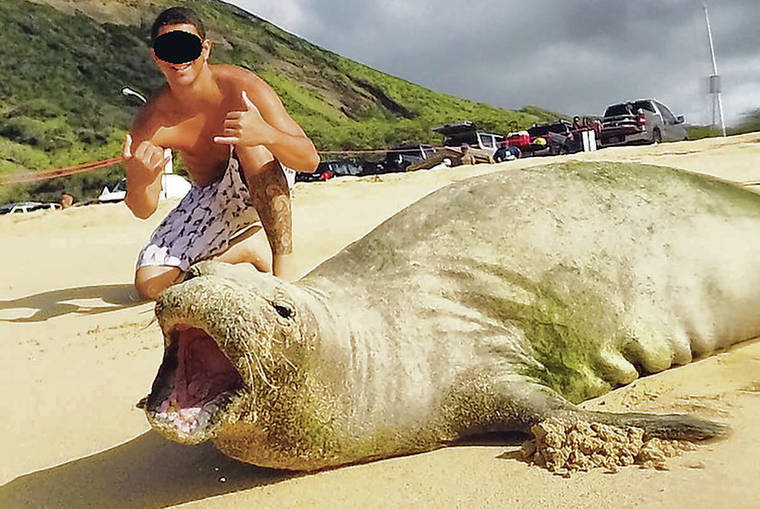Want a selfie with a Hawaiian monk seal? Don’t get too close.
National Oceanic and Atmospheric Administration researchers recently conducted a study Opens in a new tab of how social media can play a role not only in monitoring the public’s interaction with endangered monks seals in Hawaii, but in research, education and conservation.
During a one-year period from October 2014 to September 2015, NOAA scientists Mark Sullivan, Stacie Robinson and Charles Littnan analyzed 2,392 Instagram posts, with the hashtag #monkseal, to evaluate human disturbance and behavioral concerns.
As the population of seals in the main Hawaiian Isles continues to grow, interactions with humans become more inevitable as the seals haul out to rest and give birth to pups. The prevalence of social media could prove useful in offering real-time data.
NOAA’s viewing guidelines Opens in a new tab recommend remaining 15 meters, or 50 feet, away from a seal resting on a shoreline.
What researchers found is that approximately 22% of the photos indicated people were within 3 meters, or about 10 feet, of a seal, which is too close, according to NOAA. The researchers were able to analyze the characteristics of the photo to determine how far away the person taking the photo was from the seal.
“That (10 feet away) is way too close,” said Mark Sullivan, NOAA researcher and co-author of the study. “Most of the time, it was the photographer, and we conservatively estimated they were within 10 feet.”
The study found that 18% of the posts showed a monk seal responding to some type of disturbance by looking, moving away, or mouthing or barking.
This, according to Sullivan, was much higher than the 0.64% of disturbances reported traditionally, by volunteers or members of the public by contacting NOAA via email or its hotline, which was surprising.
Still, a large majority, 82%, of the interactions with humans led to no response from the monk seals, according to the study.
Sullivan said when he started his own Instagram account in 2012, the first hashtag he searched for was #monkseal, and he was surprised how many posts there were of people too close to seals. He also discovered he could recognize seals posted in the photos due to scars and markings.
So he decided to quantify the data available through social media posts in what he considers a progressive type of study.
Sullivan acknowledged social media’s downfalls: Sometimes the posts can be altered, and might be shared a week or a year later, and do not offer as much accuracy as the trained network of volunteers who report on the status of the seals.
However, he concluded that social media platforms can be an effective tool for researchers to track the behavior and threats to the survival of seals, to help inform management decisions, as well as provide real-time data for population monitoring.
For example, researchers had been monitoring R329, a female monk seal who suffered from a shark bite to her face, but lost track of where she went for months. Then a social media post surfaced showing her swimming on Lanai, where few are sighted. NOAA was able to see that her wound was healing and to update her status.
Other posts might inform NOAA of the need to intervene for a specific seal, including whether it is sick, injured or entangled. It could also show when a seal is interacting too much with people, oftentimes snorkelers, in the water.
NOAA estimates roughly 30% of Hawaiian monk seals in the population today are alive due to its interventions, some of which were successful due to timely reporting by the public.
Only about 1,400 Hawaiian monk seals, or Neomonachus schauinslandi, remain in the wild, with about 1,100 in the Northwestern Hawaii Islands and 300 in the main Hawaiian Isles. The critically endangered seals, which are found only in Hawaii, are protected by both state and federal laws.
Sullivan encourages members of the public to post photos of monk seals with #monkseal, but appropriately, from a respectful distance. Sightings of monk seals in distress can also be reported to NOAA’s marine mammal hotline at 888-256-9840.
INSTAGRAM FINDINGS ON HAWAIIAN MONK SEALS
>> Posts with #monkseal from October 2014 to September 2015 were searched, which yielded 2,392 posts of wild Hawaiian monk seals.
>> 22.1% of Instagram posts examined showed people within 3 meters of a seal, due to photo characteristics.
>> 17.8% indicated a disturbance to the animal, detected by its behavior, whether it was looking, moving away or barking.
>> NOAA recommends the “rule of thumb” guideline for viewing monk seals. If you do the “thumbs up” gesture with an arm extended, and your thumb appears to cover the entire seal, you are far enough away, at about 15 meters, or 50 feet.

